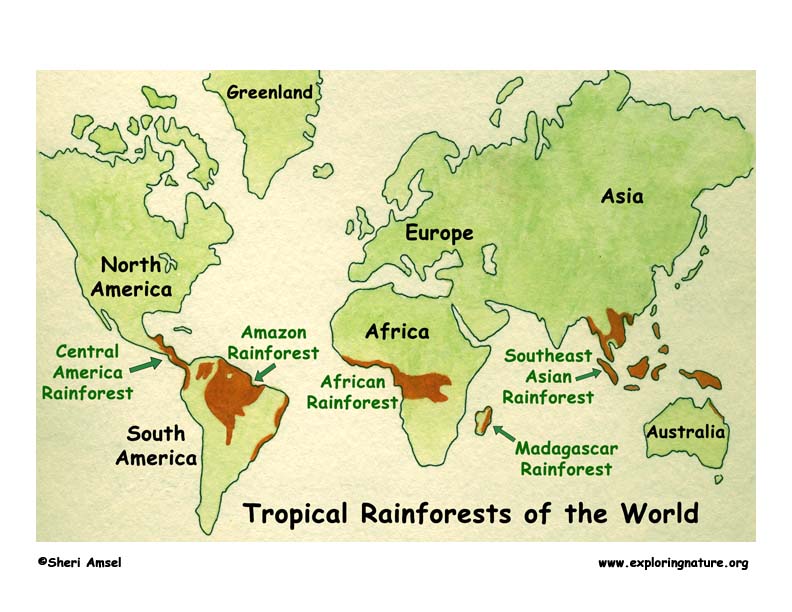

There are rainforests all over the world and though they are alike in many ways, each of them has many different types of animal and plants. What they have in common is heat, rain, and very tall trees. Rainforest trees reach to the sky to collect as much sunlight as they can, for sunlight feeds the forest. In fact, rainforests can, because of their dense greenery, collect more sunlight than any other type of wild place in the world.
What does the forest do with all that solar energy? Besides growing tall trees and thick ferns that may be 20 feet tall, it grows huge, sweet-smelling flowers, rich fruits, and strange plants called “bromeliads.” But most of all, it keeps the rainforest so hot that when the daily rains fall, they evaporate into steam. This keeps the forest dripping with moisture. That way most small animals can stay safely hidden in the treetops, eating leaves, fruits, and insects. They need not risk a visit to the ground for water.
Far below the thick tangle of trees, it is dark, wet and still on the forest floor. Only small shafts of light filter down to the dark-loving plants. Dead leaves and fruits pile up on the ground and rot, releasing all their energy back to the forest soil. Nothing is wasted in the rainforest.
Rainforests all over the world are being cut for timber and burned for ranch and farm land, even though the soil is so lacking in nutrients that cleared land is good only to grow crops for about three years. Then more rain forest is cut or burned, and all its living things are lost. If these plants and animals don’t exist in another part of the jungle that remains untouched, they are lost forever — some before they are even discovered.
People are just beginning to realize the importance of the rainforests. Many of the medicines found there cannot be made in the laboratory. The rosy periwinkle, found on Madagascar, has been discovered to contain a cure for a type of leukemia, a deadly disease of the blood.
Perhaps most importantly, as tropical rainforests absorb and release water like a great green sponge, they also absorb carbon dioxide made by cars and industry all over the world. Then, like a giant filter, they send fresh oxygen into the air. Many scientists think that in this way the rainforests actually help to control the world’s climate. Cutting down the rainforest does affect the entire earth.
When you research information you must cite the reference. Citing for websites is different from citing from books, magazines and periodicals. The style of citing shown here is from the MLA Style Citations (Modern Language Association).
When citing a WEBSITE the general format is as follows.
Author Last Name, First Name(s). "Title: Subtitle of Part of Web Page, if appropriate." Title: Subtitle: Section of Page if appropriate. Sponsoring/Publishing Agency, If Given. Additional significant descriptive information. Date of Electronic Publication or other Date, such as Last Updated. Day Month Year of access < URL >.
Amsel, Sheri. "About Rainforests" Exploring Nature Educational Resource ©2005-2024. December 13, 2024
< http://www.exploringnature.org/db/view/About-Rainforests >

